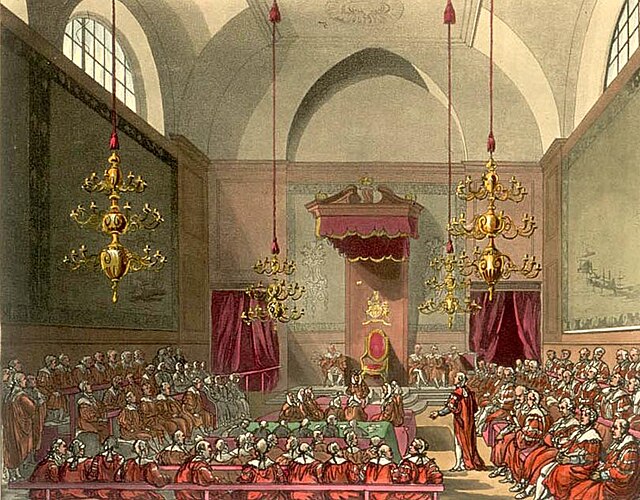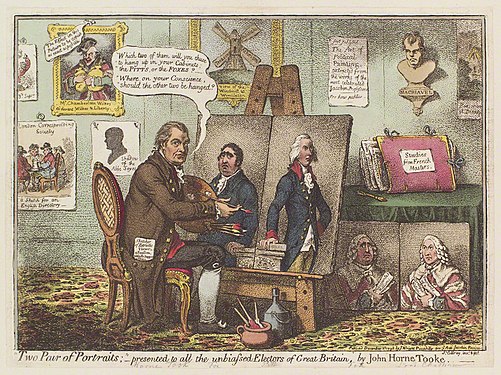| This section does not cite any sources. (November 2017) |
"Two Pair of Portraits;" – presented to all the unbiassed Electors of Great Britain, an anti-Whig caricature published in 1798 by
James Gillray showing Fox as the personification of vice next to a portrait of Pitt as the embodiment of honesty, followed by portraits of their fathers, Lord Holland and Lord Chatham displayed below. The title is an allusion to a pamphlet by
John Horne Tooke.
In
Integrity retiring from Office! (1801),
James Gillray caricatured the resignation of Pitt's ministry in 1801.
Great Britain had been at war with France since 1792. The Prime Minister since 1783, William Pitt the Younger, led a broad wartime coalition of Whig and Tory politicians.
The principal opposition to Pitt was a relatively weak faction of Whigs, led by Charles James Fox. For four years after 1797 opposition attendance at Westminster had been sporadic as Fox pursued a strategy of secession from Parliament. Only a small group, led by George Tierney, had attended frequently to oppose the ministers. As Foord observes "only once did the minority reach seventy-five, and it was often less than ten".
The Act of Union 1800 created the United Kingdom by merging the previous Kingdoms of Great Britain and Ireland. The first Parliament of the United Kingdom was composed of all the members of the last Parliament of Great Britain and some of the members of the final Parliament of Ireland.
Pitt wished to grant Catholic emancipation (the right for Roman Catholics to sit in Parliament), to help reconcile the Irish Catholic majority with the Union. King George III was opposed to that policy, so Pitt was compelled to resign in March 1801.
The new Tory Prime Minister was Henry Addington. He led another wartime administration of pro-government Whigs and Tories, collectively referred to as the "Addingtonians".[1] This was however weaker than Pitt's ministry as Pitt and his faction did not join the new government.
The younger opposition Whigs also became more involved in parliamentary opposition. Charles Grey, on 25 March 1801, tried to persuade the House of Commons to set up a Committee on the State of the Nation. His motion was lost, but it attracted 105 supporters. The Foxite leaders gradually ended their secession from Parliament.
Pitt was generally supportive of the Addington ministry, but was semi-detached from it. As the well-known couplet tellingly observed: "Pitt is to Addington, as London is to Paddington", which indicates the contemporary view of the relative abilities of the two prime ministers.
All British MPs and those Irish members representing constituencies which retained two members after the Union (the 32 Irish counties and the cities of Dublin and Cork) automatically retained their seats when the Union took effect on 1 January 1801.
Those members of the Irish House of Commons to sit at Westminster, who represented constituencies still enfranchised after the Union but reduced from two members to one (the remaining 31 most considerable Irish boroughs and Dublin University), were selected by drawing lots. If one of the seats in the Irish Parliament was vacant, then the remaining member for the constituency was automatically chosen for the Westminster Parliament. If both seats were vacant a by-election was held.
Monmouthshire (1 County constituency with 2 MPs and one single member Borough constituency) is included in Wales in these tables. Sources for this period may include the county in England.
Table 1: Constituencies and MPs, by type and country
More information Country, BC ...
| Country |
BC |
CC |
UC |
Total C |
BMP |
CMP |
UMP |
Total MPs |
|---|
 England England |
202 |
39 |
2 |
243 |
404 |
78 |
4 |
486 |
| Wales |
13 |
13 |
0 |
26 |
13 |
14 |
0 |
27 |
 Scotland Scotland |
15 |
30 |
0 |
45 |
15 |
30 |
0 |
45 |
 Ireland Ireland |
33 |
32 |
1 |
66 |
35 |
64 |
1 |
100 |
| Total |
263 |
114 |
3 |
380 |
467 |
176 |
5 |
658 |
Close
Table 2: Number of seats per constituency, by type and country
More information Country, BCx1 ...
| Country |
BCx1 |
BCx2 |
BCx4 |
CCx1 |
CCx2 |
UCx1 |
UCx2 |
Total C |
|---|
 England England |
4 |
196 |
2 |
0 |
39 |
0 |
2 |
243 |
| Wales |
13 |
0 |
0 |
12 |
1 |
0 |
0 |
26 |
 Scotland Scotland |
15 |
0 |
0 |
30 |
0 |
0 |
0 |
45 |
 Ireland Ireland |
31 |
2 |
0 |
0 |
32 |
1 |
0 |
66 |
| Total |
63 |
198 |
2 |
42 |
72 |
1 |
2 |
380 |
Close




